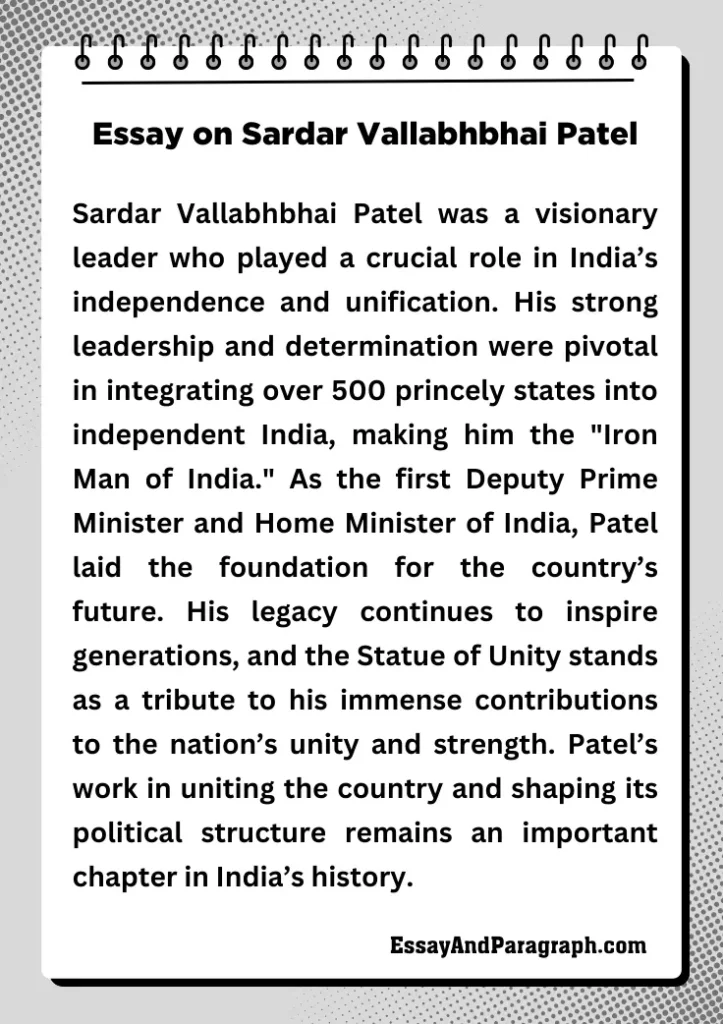Have you ever heard of the Iron Man of India? Sardar Vallabhbhai Patel was a great leader who played a significant role in India’s independence and unity. Known for his firm determination and leadership qualities, Patel helped unite India into one nation after independence. His efforts in the political and social fields continue to inspire people worldwide.
In this article, we will learn about Sardar Vallabhbhai Patel’s life, his contributions to India, and how he helped shape the future of the country.
10 Lines Essay on Sardar Vallabhbhai Patel in English
Sardar Vallabhbhai Patel was born on October 31, 1875, in Nadiad, Gujarat.
He is known as the “Iron Man of India” for his strong will and leadership.
Patel played an important role in the Indian independence movement.
He was a key member of the Indian National Congress.
Sardar Patel was instrumental in the integration of over 500 princely states into India.
He served as the first Deputy Prime Minister and Home Minister of independent India.
He was a close associate of Mahatma Gandhi and worked on many campaigns.
Patel believed in the unity of India and worked hard to achieve it.
His efforts in shaping India’s political structure are still remembered today.
Sardar Vallabhbhai Patel passed away on December 15, 1950, but his legacy lives on.

10 Lines Essay on Sardar Vallabhbhai Patel
Short Essay on Sardar Vallabhbhai Patel in English for Students
Sardar Vallabhbhai Patel was a remarkable leader, who played a significant role in shaping India’s political landscape. Born in 1875 in Nadiad, Gujarat, Patel showed great promise from a young age. He studied law and became a successful lawyer. However, his true calling came when he joined the Indian National Congress and became involved in the struggle for India’s independence.
Patel was deeply influenced by Mahatma Gandhi’s philosophy of nonviolence and became one of his closest allies. Together, they fought against British colonial rule and worked towards the betterment of the nation. One of Patel’s most important contributions was his role in integrating more than 500 princely states into the newly formed Indian Union. His diplomatic skills and persuasive leadership made it possible for these states to join India, which otherwise could have led to disunity.
As the first Deputy Prime Minister and Home Minister of independent India, Patel worked tirelessly to maintain law and order in a newly independent country. He was instrumental in addressing the challenges faced by the newly formed nation and worked towards building a strong foundation for India’s political system. His leadership and determination earned him the title of the “Iron Man of India.”
Sardar Vallabhbhai Patel’s vision and leadership continue to inspire the people of India, and his legacy is celebrated every year on his birth anniversary, October 31, as National Unity Day.
Long Essay on Sardar Vallabhbhai Patel in English for Students
Sardar Vallabhbhai Patel, also known as the “Iron Man of India,” was one of the greatest leaders in Indian history. Born in 1875 in Nadiad, Gujarat, Patel was initially an ordinary farmer’s son. His early life was marked by hard work and determination, which helped him develop the character that would later define his leadership. Patel’s journey into politics began after he joined the Indian National Congress in the early 1900s. He soon emerged as a key leader in the freedom movement, alongside Mahatma Gandhi.
One of Patel’s most significant contributions was during the time of India’s independence. He was crucial in uniting over 500 princely states that were reluctant to join the newly formed Indian Union. At the time of independence in 1947, India was divided into provinces under British rule and more than 500 princely states, each with its own ruler. Sardar Patel, with his firm determination and leadership skills, managed to bring these states together, thus securing the integrity and unity of the nation. His efforts in integrating these states were crucial to ensuring India’s unity, making him one of the key architects of India’s post-independence stability.
In addition to his work in uniting India, Sardar Patel served as the first Deputy Prime Minister and the Home Minister of independent India. As Home Minister, Patel took charge of rebuilding the nation and solving various challenges, including the refugee crisis caused by the partition of India. He worked relentlessly to maintain law and order during the tumultuous period that followed independence.
Sardar Vallabhbhai Patel’s leadership was characterized by pragmatism, courage, and determination. His ability to maintain unity during such difficult times and his dedication to the cause of a united India earned him the admiration of millions. His contributions to the nation’s political, social, and economic development remain relevant even today. In recognition of his immense contribution, the Statue of Unity was built in his honor, making him a symbol of India’s strength and unity.
Sardar Patel’s legacy continues to inspire generations. His contributions to the independence and unity of India are unmatched, and his leadership serves as a beacon of hope for the country. He is remembered as one of the most important figures in Indian history, whose vision and determination shaped the India we know today.
FAQs on Sardar Vallabhbhai Patel
1. Who was Sardar Vallabhbhai Patel?
Sardar Vallabhbhai Patel, born in 1875 in Gujarat, was an Indian leader and the first Deputy Prime Minister of independent India. Known as the “Iron Man of India,” he played a key role in the country’s independence and worked tirelessly for national unity by integrating the princely states into India.
2. What was Sardar Patel’s role in India’s independence?
Sardar Patel was a prominent leader in the Indian freedom struggle. He led several movements against the British and was a close associate of Mahatma Gandhi. He played a crucial role in the Non-Cooperation Movement and the Salt March, helping India achieve independence in 1947.
3. Why is Sardar Patel called the “Iron Man of India”?
Sardar Patel earned the title “Iron Man of India” because of his strong will and determination. He successfully united over 500 princely states into independent India, ensuring the country’s territorial integrity. His firm leadership during challenging times earned him this title.
4. What was the contribution of Sardar Patel in the integration of princely states?
After India gained independence, many princely states were reluctant to join the Indian Union. Sardar Patel used diplomacy and persuasion to integrate these states, ensuring that India remained united and preventing the breakup of the nation.
5. How did Sardar Patel impact the political landscape of India?
Sardar Patel’s leadership as the first Home Minister of India was pivotal in shaping the country’s political structure. He played a key role in formulating policies for governance, law, and order, and worked towards ensuring national unity and stability.
6. What is the Statue of Unity?
The Statue of Unity, located in Gujarat, is a statue of Sardar Vallabhbhai Patel. Standing at 182 meters, it is the tallest statue in the world. The statue was built to honor Patel’s contributions to India and his role in uniting the country after independence.
Top 5 Quotes on Sardar Vallabhbhai Patel
“I am not a man of words, but a man of action.” – Sardar Vallabhbhai Patel
“The integration of India was not only a political necessity, but also a moral necessity.” – Sardar Vallabhbhai Patel
“Manpower without unity is not a strength unless it is harmonized and united properly, then it becomes a spiritual power.” – Sardar Vallabhbhai Patel
“We should not forget the sacrifices of the people who fought for the freedom of India.” – Sardar Vallabhbhai Patel
“Unity is the need of the hour. Unity is the strength of the nation.” – Sardar Vallabhbhai Patel
Summary
Sardar Vallabhbhai Patel was a visionary leader who played a crucial role in India’s independence and unification. His strong leadership and determination were pivotal in integrating over 500 princely states into independent India, making him the “Iron Man of India.” As the first Deputy Prime Minister and Home Minister of India, Patel laid the foundation for the country’s future. His legacy continues to inspire generations, and the Statue of Unity stands as a tribute to his immense contributions to the nation’s unity and strength. Patel’s work in uniting the country and shaping its political structure remains an important chapter in India’s history.





